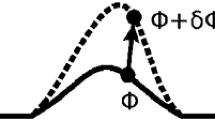Abstract
In this paper we present a discrete adjoint approach for the optimization of unsteady, turbulent flows. While discrete adjoint methods usually rely on the use of the reverse mode of Automatic Differentiation (AD), which is difficult to apply to complex unsteady problems, our approach is based on the discrete adjoint equation directly and can be implemented efficiently with the use of a sparse forward mode of AD. We demonstrate the approach on the basis of a parallel, multigrid flow solver that incorporates various turbulence models. Due to grid deformation routines also shape optimization problems can be handled. We consider the relevant aspects, in particular the efficient generation of the discrete adjoint equation and the parallel implementation of a multigrid method for the adjoint, which is derived from the multigrid scheme of the flow solver. Numerical results show the efficiency of the approach for a shape optimization problem involving a three dimensional Large Eddy Simulation (LES).
Similar content being viewed by others
References
FASTEST User Manual: Fachgebiet Numerische Berechnungsverfahren im Maschinenbau. Technische Universität Darmstadt (2005)
MPI: A message-passing interface standard, Version 2.2. Message Passing Interface Forum (2009)
Balay, S., Brown, J., Buschelman, K., Eijkhout, V., Gropp, W., Kaushik, D., Knepley, M., McInnes, L., Smith, B., Zhang, H.: Petsc Users Manual Revision 3.2 (2011)
Briggs, W., Henson, V., McCormick, S.: A multigrid tutorial. Society for Industrial Mathematics (2000)
Carnarius, A., Thiele, F., Özkaya, E., Gauger, N.: Adjoint approaches for optimal flow control. In: 5th Flow Control Conference, AIAA Paper AIAA-2010-5088, Chicago, Illinois (2010)
Chien, K.Y.: Predictions of channel and boundary-layer flows with a low-Reynolds-number turbulence model. AIAA J. 20(1), 33–38 (1982)
Christianson, B.: Reverse accumulation and attractive fixed points. Optim. Methods Softw. 3(4), 311–326 (1994)
Durst, F., Schäfer, M.: A parallel block structured multigrid method for the prediction of incompressible flows. Int. J. Numer. Methods Fluids 22(6), 549–565 (1996)
Elman, H., Howle, V., Shadid, J., Shuttleworth, R., Tuminaro, R.: A taxonomy and comparison of parallel block multi-level preconditioners for the incompressible Navier-Stokes equations. J. Comput. Phys. 227(3), 1790–1808 (2008)
Germano, M.: Turbulence: the filtering approach. J. Fluid Mech. 238, 325–336 (1992)
Giering, R., Kaminski, T., Slawig, T.: Generating efficient derivative code with TAF: adjoint and tangent linear Euler flow around an airfoil. Future Gener. Comput. Syst. 21(8), 1345–1355 (2005)
Giles, M.: On the use of Runge-Kutta time-marching and multigrid for the solution of steady adjoint equations. Tech. Rep. 00/10, Oxford (2000)
Griewank, A.: Achieving logarithmic growth of temporal and spatial complexity in reverse automatic differentiation. Optim. Methods Softw. 1, 35–54 (1992)
Griewank, A., Walther, A.: Evaluating Derivatives, 2nd edn. Society for Industrial and Applied Mathematics, Philadephia, PA (2008)
Grundmann, S., Tropea, C.: Experimental damping of boundary-layer oscillations using DBD plasma actuators. In: The Seventh International Symposium on Engineering Turbulence Modelling and Measurements, ETMM7. International Journal of Heat and Fluid Flow, vol. 30, no. 3, pp. 394–402 (2009)
Gu, T., Zuo, X., Liu, X., Li, P.: An improved parallel hybrid bi-conjugate gradient method suitable for distributed parallel computing. J. Comput. Appl. Math. 226(1), 55–65 (2009)
Gunzburger, M., Wood, H.G., III: Perspectives in flow control and optimization. Appl. Mech. Rev. 56(6), 57–62 (2003)
Hess, W., Ulbrich, S.: An inexact ℓ1 penalty SQP algorithm for PDE constrained optimization with an application to shape optimization in linear elasticity. Optim. Methods Softw (2012). doi:10.1080/10556788.2011.651082
Hinze, M.: Control of weakly conductive fluids by near wall Lorentz forces. GAMM-Mitteilungen 30(1), 149–158 (2007)
Hinze, M., Pinnau, R., Ulbrich, M., Ulbrich, S.: Optimization with PDE Constraints, Mathematical modelling, vol. 23. Springer, Dordrecht, NL (2009)
Jones, W., Launder, B.: The prediction of laminarization with a two-equation model of turbulence. Int. J. Heat Mass Transfer 15, 301–314 (1972)
Kretz, F.: Auslegung, Konstruktion und Erprobung einer Druckgradienten-Messstecke. Diplomarbeit, Technische Universität Darmstadt (2006)
Nadarajah, S., Jameson, A.: Optimum shape design for unsteady flows with time-accurate continuous and discrete adjoint methods. AIAA J. 45(7), 1478 (2007)
Özkaya, E., Gauger, N.: An efficient one-shot algorithm for aerodynamic shape design. New Results in Numerical and Experimental Fluid Mechanics VII, pp. 35–42 (2010)
Quarteroni, A., Valli, A.: Domain Decomposition Methods for Partial Differential Equations. Clarendon Press (1999)
ur Rehman, M., Vuik, C., Segal, G.: Preconditioners for the steady incompressible Navier-Stokes problem. Int. J. Appl. Math. 38, 223–232 (2008)
Saad, Y., Schultz, M.: GMRES: a generalized minimal residual algorithm for solving nonsymmetric linear systems. SIAM J. Sci. Statist. Comput. 7(3), 856–869 (1986)
Schlenkrich, S., Walther, A., Gauger, N., Heinrich, R.: Differentiating fixed point iterations with ADOL-C: gradient calculation for fluid dynamics. In: Bock, H.G., Kostina, E., Phu, H., Rannacher, R. (eds.) Modeling, Simulation and Optimization of Complex Processes – Proceedings of 3rd HPSC 2006, pp. 499–508 (2008)
Segar, M.K.: A SLAP for the Masses, pp. 135–155. John Wiley & Sons, Inc., New York, NY, USA (1989)
Smagorinsky, J.: General circulation experiments with the primitive equation. Mon. Weather Rev. 91(3), 99–164 (1963)
Ulbrich, M., Ulbrich, S.: Automatic differentiation: a structure-exploiting forward mode with almost optimal complexity for Kantorovič trees. Applied Math Parallel Comput, pp. 327–357 (1996)
Walther, A.: Program reversal schedules for single- and multi-processor machines. Ph.D. thesis, Institute of Scientific Computing, Technical University Dresden, Germany (1999)
Wilcox, D.C.: Turbulence Modeling for CFD. DCW Industries (1994)
Yakhot, V., Orszag, S.A., Thangam, S., Gatski, T.B., Speziale, C.G.: Development of turbulence models for shear flows by a double expansion technique. Phys. Fluids 4, 1510–1520 (1992)
Zymaris, A., Papadimitriou, D., Giannakoglou, K., Othmer, C.: Continuous adjoint approach to the Spalart-Allmaras turbulence model for incompressible flows. Comput. Fluids 38(8), 1528–1538 (2009)
Author information
Authors and Affiliations
Corresponding author
Rights and permissions
About this article
Cite this article
Roth, R., Ulbrich, S. A Discrete Adjoint Approach for the Optimization of Unsteady Turbulent Flows. Flow Turbulence Combust 90, 763–783 (2013). https://doi.org/10.1007/s10494-012-9439-3
Received:
Accepted:
Published:
Issue Date:
DOI: https://doi.org/10.1007/s10494-012-9439-3




